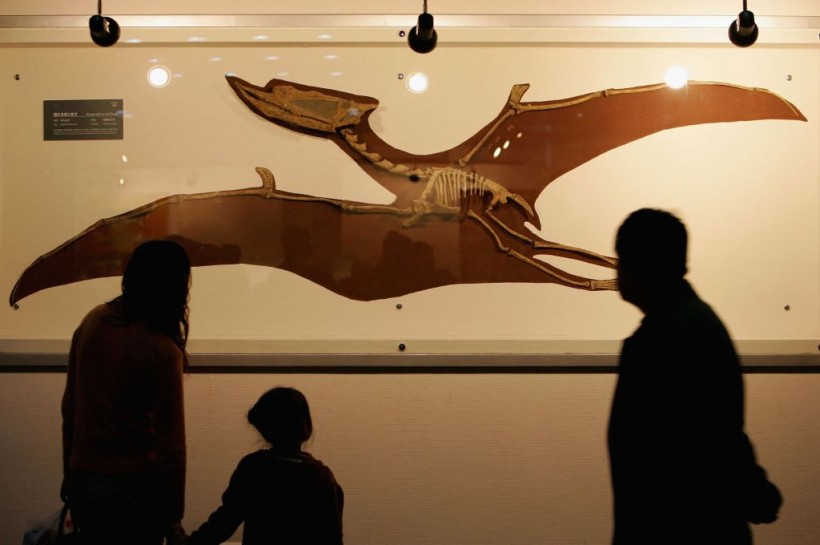Professor Paul Barrett, along with colleagues, highlights the enduring presence of the pterosaur group from the Late Triassic to the Cretaceous extinction. Their recent announcement introduces a novel pterosaur species discovered in specimens from the Isle of Skye, an island renowned for its rugged landscapes, situated just off the northwest coast of mainland Scotland.
Their study, titled "A new pterosaur from Skye, Scotland and the early diversification of flying reptiles" which will be published in the Journal of Vertebrate Paleontology, contributes to the current understanding of the group's remarkable longevity across various geological epochs.

Visitors view a fossil specimen of a pterosaur at the Geological Museum of China during an activity to mark World Earth Day April 22, 2006 in Beijing, China.
Ceoptera evansae: A New Middle Jurassic Pterosaur Species
The groundbreaking study unveils Ceoptera evansae, a new pterosaur species thriving approximately 168-166 million years ago during the Middle Jurassic era.
Led by palaeobiologist Liz Martin-Silverstone from the University of Bristol, the study significantly enriches the scarce fossil record of Middle Jurassic pterosaurs. With an estimated wingspan akin to an osprey at 1.6 meters, Ceoptera evansae provides novel insights into the size and characteristics of these ancient flying reptiles.
The newly identified species is based on the remains of a lone individual, featuring an incomplete skeleton encompassing shoulders, wings, legs, and backbone. Many bones are still encased in rock, demanding the use of CT-scanning techniques for meticulous examination.
The nomenclature Ceoptera combines the Scottish Gaelic word "Cheò," meaning "mist," reflecting the Isle of Skye's Gaelic name as the "Isle of Mist," with the Latin suffix "-ptera," signifying "wing." The second part of the name pays tribute to researcher Susan Evans for her impactful contributions to the Isle of Skye.
Ceoptera's distinctiveness is evident in unique features related to muscle attachment areas not observed in other animals. Evolutionary analysis firmly places Ceoptera within the Darwinoptera clade, challenging existing debates on its validity and alternative classifications like Wukongopteridae.
This discovery broadens current comprehension of Darwinoptera's diversity, indicating a prolonged existence spanning over 25 million years from the late Early Jurassic to the later Jurassic period, highlighting widespread dispersion across the globe during this extensive timeframe.
READ ALSO: Giant Pterosaur with Neck Longer Than Giraffes' Flew 100 Million Years Ago, Scientists Believe
Pterosaurs: Evolutionary History and Distribution Insights
Pterosaurs, present on every continent, exhibited two significant peaks in species richness during the Early-Middle Cretaceous and late Cretaceous periods, influencing understanding of their evolutionary history. However, their distribution is notably shaped by the 'Lagerstätten effect' and sampling biases, limiting knowledge to a few sites with restricted spatiotemporal coverage.
These extinct flying reptiles emerged over 200 million years ago, coexisting with dinosaurs, and vanished during the mass extinction event approximately 66 million years ago, coinciding with the demise of their dinosaur relatives.
The recent study challenges prevailing models, proposing a more intricate early evolution of pterosaurs. In contrast to prior beliefs, all major pterosaur clades emerged well before the end of the Early Jurassic. The findings suggest their persistence into the later parts of the Jurassic alongside the group that eventually evolved into modern birds.
This discovery advances understanding of when and where advanced pterosaurs evolved, contributing to a more nuanced understanding of their evolutionary timeline.
Lastly, it underscores the impact of the 'Lagerstätten effect' and sampling biases on pterosaur knowledge, emphasizing the need to consider these factors when interpreting their distribution and evolutionary history. With this revelation, the research takes a step closer to unraveling the mysteries surrounding the early evolution of pterosaurs and their coexistence with other prehistoric creatures.
RELATED ARTICLE: 86-Million-Year-Old Fossil of Pterosaur Dubbed "Dragon of Death" Unearthed in Argentina, Classified as One of the Largest Flying Reptiles
Check out more news and information on Paleontology in Science Times.



![Earth's Quasi-Moon Kamo‘oalewa Could Originate From Lunar Surface Not Asteroid Belt [Study]](https://1721181113.rsc.cdn77.org/data/thumbs/full/53275/89/56/50/40/earths-quasi-moon-kamo-oalewa-could-originate-from-lunar-surface-not-asteroid-belt-study.png)










